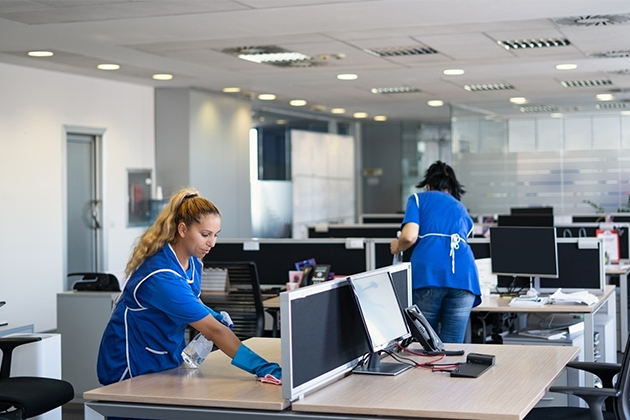The ROI Of A Clean Workplace: Unseen Benefits Revealed A clean workplace has obvious benefits because sanitary practices are essential in keeping employees healthy and productive. Companies are bent on ensuring an optimal work environment because the bottom line is affected by sick employees and decontamination downtime.
This is a health concern because, despite stringent measures, there were still reported increases in incidents, particularly in the retail, transportation, and warehousing sectors. This article discusses the good returns from having a clean workplace and other unseen benefits.
Germs in the Workplace
Before we discuss the return on investment (ROI) of a clean workplace, it’s essential to understand where germs commonly lurk. Because of their size and resistance, regular cleaning may not be sufficient. Professionals like Fort Worth Commercial Cleaning Service are usually hired to thoroughly beyond the visible grime.
A study showed that 80% of contamination is hand-borne. However, it does not need to be direct, like a handshake. Contamination can spread through surfaces and shared workstations. Staphylococcus, spore-forming bacteria and the more deadly Gram-negative bacteria are the most common pathogens that can survive for weeks after being deposited.
It’s not only when there’s a pandemic threat that vigilance is observed because the following common areas are hotspots for bacteria, protozoa, and viruses, even if they don't appear dirty to the naked eye:
- Desks and Workstations: Personal workspace can harbor an alarming number of germs. Keyboards, mice, and office phones are especially notorious for collecting bacteria because they are difficult to clean. Eating at workstations adds to the bacteria load, and any moisture becomes a breeding ground for molds and bacteria.
- Bathrooms: Unsurprisingly, restrooms are a breeding ground for germs, including those causing illnesses such as colds, flu, and stomach infections.
- Kitchen Areas: Shared kitchenettes or break rooms are prime locations for germ transmission. Contaminated surfaces, unwashed dishes, and improperly stored food can all contribute to the problem.
- Elevators and Common Areas: High-touch surfaces like elevator buttons, handrails, and doorknobs can rapidly spread germs throughout an office building.
- Meeting Rooms: Frequent meetings often lead to close contact and shared equipment, increasing the risk of disease transmission.
Germs can spread through various means, such as direct contact, airborne transmission, indirect contact, and food contamination.
Economic Loss of a Sick Workforce
According to the U.S. Bureau of Labor Statistics, in 2021, employees missed an average of 1.0 days of work due to illness or injury. While this may not seem significant, the collective cost to businesses is substantial.
- Lost Productivity: When employees are absent due to illness, companies experience a decrease in productivity. This lost productivity is estimated to cost U.S. employers billions of dollars annually. This becomes worse when the infection spreads, and more than one employee is affected.
- Healthcare Costs: Sick employees may require medical attention, which can increase healthcare expenses for both the employee and the employer, particularly if the organization provides healthcare coverage.
- Replacement and Overtime Costs: To compensate for absent employees, businesses may need to hire temporary staff or pay overtime to existing employees, incurring additional costs.
- Negative Impact on Morale: A workplace plagued by illness can lead to low employee morale and job dissatisfaction, potentially leading to higher turnover rates.
- Reduced Quality of Work: Even when employees come to work despite feeling unwell, their ability to perform at their best is compromised, potentially affecting the quality of their work.
The Unseen ROI of a Clean Workplace
- Reduced Absenteeism: Maintaining a clean workplace significantly reduces the spread of germs, resulting in fewer sick days taken by employees. According to a study published in the American Journal of Infection Control, organizations implementing effective cleanliness measures experienced a 24% reduction in employee absenteeism due to illness.
- Increased Productivity: A clean and organized workspace fosters a positive work environment. A National Association of Professional Organizers survey found that 91% of respondents felt more productive in a clean workspace. Improved productivity directly translates into increased ROI.
- Enhanced Employee Well-being: A clean workspace is conducive to better physical and mental health. When employees feel healthy and comfortable at work, job satisfaction increases, leading to lower turnover rates and reduced recruitment costs.
- Positive Company Image: A clean and hygienic workplace benefits employees and creates a positive impression on clients, partners, and visitors. This can enhance a company’s reputation and potentially attract more business opportunities.
- Cost Savings: While investing in regular cleaning services may seem like an expense, the long-term cost savings are substantial. Preventing illness-related absenteeism and reducing the need for employee replacements or overtime can yield a high ROI.
Conclusion
The ROI of a clean workplace is multifaceted, encompassing both tangible and intangible benefits. Beyond the visible cleanliness, a pristine work environment can reduce absenteeism, boost productivity, and enhance employee well-being. It also contributes to a positive company image and, in the long run, results in cost savings that far outweigh the investment in cleanliness.
In an era where health and well-being are paramount, businesses in the United States must recognize the significance of maintaining a clean workspace. By investing in cleanliness and hygiene measures, organizations can reap the unseen benefits of a healthier, more productive, and economically efficient workforce.











